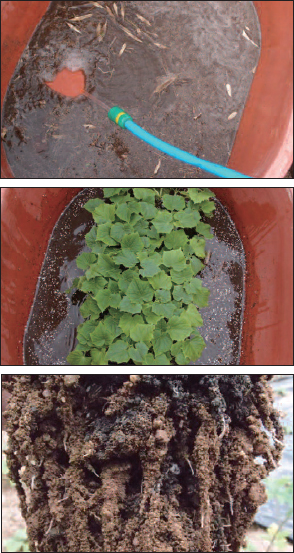

Photo: Youngsang Cho
Conventional farming cannot solve the problem of soil compaction. You might be frustrated by this fact, but nothing can be clearer: continuing conventional agriculture and bringing back life to soil are not compatible
1.The current state of our soil
Soil contaminated by antibiotics, chemical pesticides and fertilizers
According to Ministry of Food and Drug Safety (Korea) and Organization for Economic Co-operation and Development (OECD), Korea is classified as heavy-user country in terms of antibiotics for livestock, and pesticide and chemical fertilizer for crops. Major Asian countries are similar. Antibiotics, synthetic pesticide and fertilizers have seriously degraded the soil. Roots of all types of crops have great difficulty settling in the soil. But agricultural policy promoting the use of chemical fertilizer and pesticide does not change. Some renowned agricultural experts and columnists defend conventional chemical agriculture and launch attacks on organic farming citing various reasons. How can they be not concerned about the chemicals poured into the soil and their impact?
Soil degradation is global; it is fast bringing the death of agriculture. Agriculture should look one hundred years into the future. Conventional farming simply is not sustainable. Any farming that degrades soil will destroy the future of farming. Soil contamination is linked to human contamination. If soil is diseased, so will humans. If soil dies, so will we. We must change the current chemical-intensive farming. Stop using toxic substances!
Chemicals accumulate in surface soil due to soil compaction
If antibiotics, chemical pesticides, herbicides and fertilizers that are used every year were diffused and decomposed in soil, the problem would not be as serious. Unfortunately, the fact is that they actually accumulate in the 15 cm (6 in) belt below the surface because of a layer of compacted soil. Use of heavy machinery is a direct cause of soil compaction. Tractors are the main culprit. The heavy wheels of a tractor press down on the soil and their effect can be measured as deep as 7 meters (23 ft). Repeated use of heavy vehicles turns the soil layer at 15 cm (6 in) depth rock-hard. Because of this compacted soil layer, the agricultural chemicals cannot penetrate deep into the soil and enter a breakdown cycle. Instead they will linger at the 15 cm (6 in) sub-surface level after water has evaporated. This residue is highly detrimental to crop roots. JADAM recommends you to stop using heavy tractors but use light vehicles instead and minimize the use of chemical material. Come down from the heavy machines. If you have to use tractors, then take the extra care so that the wheels will not run over crop-growing area.
What is visible (crop aboveground) represents the invisible (root condition)
Elderly people will remember that just a few decades ago it was common to grow pepper and harvest until the autumn frost. The farmers of old days did not have microorganism products, synthetic fertilizers or get education on scientific pepper cultivation like their modern counterparts, however, they easily grew wonderful peppers. Today, farmers have an abundance of products to choose from; they have abundant opportunities to get education. Ironically, not many farmers nowadays manage to grow and harvest pepper until the frost. The situation has become such that some farmers would say that pepper is the most difficult crop to grow on open fields. But for our ancestors, pepper was one of the easiest. Why did it become like so? Is it because canker and other soil-borne disease became rampant? Then, we must ask again, why did it become rampant? The root cause is in the roots. Root of peppers are not settling properly into the soil. In the past, peppers would grow so robust that farmers could not pull it out with hands; they had to use sickles to chop them down. Now, a small tug will pull the pepper roots out of the soil right away. 30-40 years ago, pepper plants used to extend their roots 1.5 m (5 ft) into the soil.
You can judge the quality of the soil by looking at how the crop roots are doing in it. In good soil, the root extends wide and deep; this guarantees high yield and high quality. It is common sense – if roots settle well with increased surface area, more water and nutrients become available for the crop. Somehow in modern agriculture, soil management became a question of “what fertilizer should I put in?” This view promotes the sales of fertilizers and similar products; but fundamentally soil management is much more than that.
Only a healthy, sustainable and back-to-the-basics mode of farming that tends to the roots and the soil can survive the age of climate change. Super-high temperature and abnormal rainfall are posing significant challenges to farming. Instead of expecting and relying on technological break-through, let us go back to the basics of farming. Farming starts with soil management.

Chinese cabbage farming has also become difficult. The problem is the same. Roots show the same coiling as the pepper.
If you continue to use factory-produced livestock manure containing antibiotics, chemical fertilizer and pesticide, soil contamination will get worse, productivity will drop and farming will become increasingly difficult. It has become a norm to use hormones and antibiotics in raising animals. Excrements from these animals are turned into manure and supplied to farms. The price is very cheap because of government support. When antibiotics build up in the soil, they destroy the microorganisms. This leads to further hardening of soil. Any form of farming should be judged based on its ability to sustain production. It is a compromising of our future to continue this form of farming that contaminates the soil with chemicals.

Now most peppers’ roots are coiled up. These roots were desperate to stay in the nursery soil. Pepper farming has become difficult because of soil degradation.
Supported by the US Department of Agriculture (USDA), scientists from the University of Minnesota conducted a study into whether crops grown with compost containing antibiotics accumulate the chemical within their tissue. The observation was that the antibiotics do move into the plants and the concentrations became higher as the use of manure increased. In particular, root vegetables such as potatoes, carrots, and radish that come into direct contact with soil were far more vulnerable to antibiotics contamination. Use of antibiotics in the livestock industry is not only contaminating the soil but also putting the health of the crops and consumers at risk. That is why organic farming bans the use of such livestock waste. Food going into my mouth determines my health; manure going into the soil determines the health of the crops. Eat whole foods for your body and apply wholesome fertilizers for the crops.

Crystalized chemicals are clearly observable. They come from continued application of chemical fertilizer, pesticide, herbicide, etc. on top of a hardened layer of compacted soil. The plow pan is formed by use of heavy machines. (Photo: Jim Richardson)
2.Roots represent the soil condition
From buyer to farmer
There are many education programs on soil management but they seem to miss the point. Students are invariably left more confused than before from the deluge of misinformation. Proper soil management is not difficult, complicated, or expensive. It does not require a multitude of corporate-produced and promoted inputs and machinery. Let us begin from the basics. If you look at a plant, you have the aboveground part and the underground part. You can see that the space they take up can be put into a ratio. The essence of soil management is making this ratio of underground part to aboveground part higher than one. That means if the aboveground part is one, the underground part has to be larger than one. The underground, invisible part should be bigger, larger and more vigorous. The total area of the root extension decides crop health; it is the basic condition for high yield and good quality. In other words, root area equals money. Soil management and ensuring good root growth is your best bet, particularly in this era of climate change.
Check the compacted soil layer
Check the presence of soil compaction with a simple method. First, dig about 40 cm (8 in) vertically into your soil. Take out a chunk from 20 cm (16 in)-depth. If that chunk contains a lot of roots (see picture), it means the soil is free from soil compaction. If you cannot find any roots in soil deeper than 20 cm (8 in), then check a few more spots. If all spots return the same result, you can conclude that a layer of compacted soil is covering your entire field. Another method is to use a sharp iron rod. Stick it into the soil. If you cannot push it in, it’s likely you have soil compaction. If you have confirmed soil compaction, take this seriously. Make all efforts to get rid of it. This is the main reason why farming becomes so difficult. If you’ve done everything you can but still your crops are suffering from diseases and yield is small, it is likely that soil compaction is the underlying problem. Roots will not grow properly in compacted soil.

A lot of hairy roots below 20 cm (8 in) under the soil: a sign that there is no soil compaction
Address the root cause of soil compaction
Why do compacted soil layers form? What is the cause? As mentioned above, a plow pan is formed by the frequent use of heavy machinery (hence the name “plow” pan). Livestock manure with antibiotic residues, chemical pesticides, fertilizers and herbicides all aggravate the problem. The prevailing method of conventional farming is causing plow pan. Without discarding conventional farming, you cannot eliminate the plow pan. I have tried to find ways to reconcile soil management and conventional farming but could not. That the two are mutually exclusive has become very clear to me. You must solve soil compaction if you are to have sustained yield through the years.
Climb down from those heavy machines. They are convenient but they are the main culprit in destroying soil. For fields, greenhouses, and orchards, you must refrain from the use of heavy vehicles. If you have to use machines, use light ones. Heavy vehicles may be permitted in some exceptional methods of farming; for instance, where tractors are equipped with GPS and extreme care is given so that their wheels always travel on the same tracks and never enter areas where crop roots are growing. Absolutely avoid livestock manure that is not certified to be devoid of all antibiotics. Accumulation of antibiotics caused by habitual input of livestock manure with unclear origin inhibits the activity of soil microorganisms. This is why organic farming does not allow that kind of livestock manure. Switch over from chemicals to natural material. A soil that is contaminated by chemicals and thus has a low microbial activity does not respond to input of fertilizer. So farmers will use even more chemical fertilizer. Break away from this cycle. Learn to make simple JADAM liquid fertilizers (JLF) that can replace chemicals. Indigenous microorganisms are probably the best means in solving soil compaction. Minimize the use of chemicals and apply JADAM indigenous microorganism solution (JMS) for a prolonged period. As microbial population and diversity increase, chemicals trapped in the compacted soil layer will start to dissolve; gradually the layer will disappear. This leads to a faster decomposition of organic matter, resulting in little need for chemical fertilizer. This is very important. There are not many that present a solution to soil compaction. But based on experiences, I can speak with confidence that JMS combined with cover crop method is the best solution.

If you have to use tractors, operate them so that their wheels do not tread over the space where crops grow.
What is visible (plant) represents what is invisible (root)
We all want high yield. For a plant to produce an abundance of fruits, its nodes should be quite short with new shoots coming out continuously. That provides a large number of flower buds and fruits. This difference can produce more than a ten-fold difference in yield in the same type of crop. The root should extend wide and deep for the plant to produce new shoots for fruiting. In one word, high yield is the total area of the root that comes in contact with plant food (fertilizer). Many people think that simply applying abundant base fertilizer (fertilizer that you put in before planting) and additional fertilizer (fertilizer you apply after plants start growing) will produce more shoots. That is wrong. It’s like having only prepared a 2-meter (6.6 ft) deep foundation and trying to raise a 10-storey building! Farming begins with simple principles. What is visible (building) represents what is invisible (foundation). Plants are smart; they look at where they are growing and grow only to the extent that is possible.
3.Make your soil like leaf mold
Find the secret to soil management in nature. Look at the soil formed from leaf mold in the adjacent mountains, fields and forests. It has been there for thousands of years. These places close to your field have the environment most closely resembling your field. JADAM believes leaf mold is the ideal soil. Organic farming is all about finding answers from nature. Below are the three tenets of soil management in the JADAM organic farming:
•Microorganism composition of my field should be identical to that of the leaf mold in the mountains
•Organic matter in my field should be abundant like the leaf mold in the mountains
•Minerals in my field should be diverse like the leaf mold in the mountains
Farming will be always difficult if soil compaction and chemical contamination are not dealt with. The only solution to soil contamination is microorganisms. Just like microorganisms purifying contaminated water, our home-cultured indigenous microorganisms will be put into the soil to dissolve contaminants and turn them into plant nutrients. When soil contamination is serious, one-time application of microorganisms is not enough. JADAM recommends applying microorganisms to fields regularly (3-4 times a month) throughout the year by mixing them into irrigation water. See the results for yourself.

Soil on left is full of contaminants trapped in compacted soil layer. JADAM organic farming changes that soil into the soil on right; soil from the mountains. Just do as nature does; that is the answer
Microorganism composition of my field should be identical to that of the leaf mold in the mountains
If you have thought it is more scientific to separate microorganisms into good guys and bad guys, then the JADAM method will be a complete eye-opener. It might appear scientific to divide good and bad microorganisms, but the truth is that we do not have the power or capability to make such a distinction. It has only been a few decades since modern science started studying soil microorganisms; less than one percent of the estimated one million existing species have been studied. It is impossible to label microorganisms good or bad. Bacteria are the most numerous of all soil microorganisms. But we can hardly look into the inside of a bacterium even with the most high-tech electronic microscope. Despite the advancement in molecular biology we still know very little about the inter-relation between specific species of microorganisms.
Bacillus anthracis, a well-known “bad guy” that causes canker, is not always bad. Having them in certain numbers actually keeps other pathogens away. Toxin produced by these bacteria have the effect of inhibiting cancer growth in the human body. Bacillus anthracis cannot be simply judged as “bad.” Like all other life forms on earth, it all depends on what situation they are in. Escherichia coli are not always bad either. E. coli disintegrates fibers in the large intestine; helps us absorb nutrients and water; and synthesizes vitamins beneficial for the body. Without them, we are not able to perform ordinary digestion and absorption. Look closely at nature and you will see that “good or bad” approach is nothing but an illusion. It sounds more scientific, sophisticated, and advanced to divide microorganisms into good and bad but this is nothing more than a marketing ploy. Business people want to monopolize microorganisms and use them for profit. These agents try to create fear among farmers on the potential catastrophic harm that the “bad” microorganisms can do. They try to persuade farmers that they are uneducated, untrained non-experts who should never try to handle microorganisms. So the “good” microorganisms have effectively entered corporate hands in the form of commodity. Despite the corporate propaganda and agenda, we are the descendants of those farmers who used microorganisms effectively for thousands of years. This assault, coming in the form of science, against the method tested by time is absurd. Corporations are touting commodity that is actually inferior yet expensive. Farmers are repeatedly told that they are non-professionals and it is best to buy the latest products and technology, and buy into the newest ideas. What the professionals claim as “good” microorganisms are in fact less than 1/10,000 of the total existing species of microorganisms. Does it make sense that an iota of all existing and mingling microorganisms is selected and is sold as a panacea for the improvement of your whole field? Is that scientific? How much do the experts understand of the role played by the remaining 9,999/10,000 other species?
Similar things are happening in theories about human health. To date, over 4,000 different bacteria were reported to be found in the human stomach. Say a scientist has identified three or four of them as beneficial. Would you believe the scientist if s/he claims that merely eating a lot of those three or four types of bacteria will significantly benefit your health; and that the rest can be safely ignored? This is a matter of common sense; but why is nobody raising questions about microorganisms in agriculture?
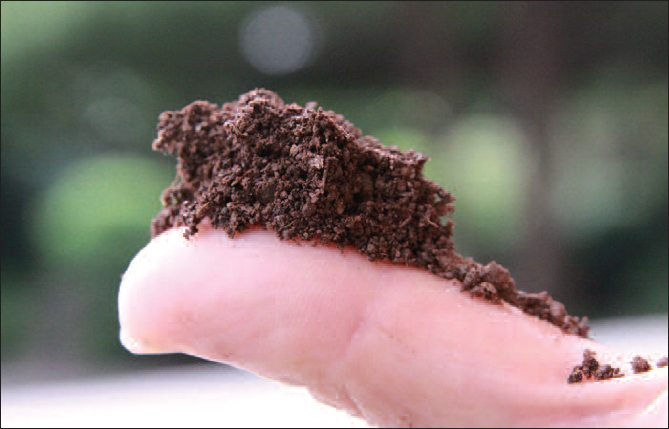
1 gram (0.04 oz) of soil from leaf mold of the mountains contains billions of microorganisms.
Our current level of using microorganisms for farming is completely immature. It is like claiming to build a Korean eco-park and then putting in a few wild animals from Japan and bringing in tropical fish from the Amazon. Microorganisms are producers of nutrients within the human digestive system and within the soil. Their excretion equals nutrients. If you select only a few microorganisms that means you are only providing a few types of nutrients for your plants. That inevitably means an imbalance of nutrients. Stop thinking of picking a few “good” microbes and using them. It is time to escape the trap of dualism.
Do not select microorganisms; they should be embraced as a whole. We should try to revitalize the whole micro-ecology as it existed in nature. Stop trying to choose but instead try to restore the long-lost balance and diversity that once was. JADAM sees microorganisms as “workers.” We need them to work underground in our fields, so we need to find and bring those who have been living in conditions most similar to that of our fields. Nowhere is there a better place to find them than the leaf mold in nearby mountains. Conversely, the tirelessly marketed products have factory-cultured microorganisms coming from Japan, the US and other distant, non-native origins.

This is what happens after leaving cooked rice in leaf mold. The colors are beautiful and diverse. Modern science has little understanding of this world of soil microorganisms.
We call the microorganisms that live in our nearby forests the “indigenous microorganisms (IMO).” Bring them home, cultivate them and use them. In 1 gram (0.04 oz) of leaf mold there are approximately 2 billion to 10 billion microorganisms. There are over one million different species. The data published by a laboratory in Denmark revealed that 1 gram of leaf mold contains 30,000 protozoa, 50,000 algae, 400,000 fungi and billions of bacteria. The best microorganism input as JADAM sees it is those optimized for your field. It should have harmony and balance between the producers, predators, and decomposers. Diversity is the foremost value. This JADAM view perfectly coincides with the principles of modern microbiology.
Science is not ready to judge which organism is beneficial or harmful. Our best choice is to accept nature as it is. The key is in the leaf mold in the surrounding mountains. Leaf mold is the key to optimization of the soil environment, balance and diversity. This is where the four thousand years of Korean organic farming is rooted. With its mountainous terrain Korea has treasures buried everywhere.
Research in agriculture should have a clear purpose of serving the public interest. The moment it loses this sense of purpose, all the findings and associated methodology (and products) too easily fall into the hands of the corporations. Instead of serving the farmers, researches will be benefiting the corporations. Microorganism is a good example. It is an essential input in organic farming yet it is completely commercialized. Managing microbes is managing nutrients for plants.
Microorganisms cannot travel without the help of water. They are somewhat like fish. However strong a microorganism might be, over 95% of its body is water and it is like an aquatic animal. It cannot simply move around inside dry soil. Microbes must be applied with water. If you want your microorganisms to reach the ends of the roots, then water must reach there; microorganisms must “swim” with the water to reach that destination. What is especially important is that you apply microbe solution fully before plants take root. Early root settlement determines the success of harvest. Early root settlement is very, very important along with water (irrigation) and nutrient (fertilizer).
JADAM indigenous microorganism solution (JMS) should be intensively applied before active root growth. Meaning, for fruit trees, that period is after leaves fall until sprouts or flowers appear next year; for field crops, from after-harvest to before transplant. In this period, you can give as much water as you want so the microbes can swim deep and thoroughly into the soil. When there are crops growing, you can’t give unlimited water so there’s a limit to microbial penetration. “Soil foundation work” refers to applying JMS plus minerals plus JADAM liquid fertilizer (JLF) before the transplanting of crop plants and the sprouting or flowering of fruit trees on a regular basis through irrigation. It looks simple enough but just put it to practice and you will be shocked at the results. This soil foundation method is the most important technology of JADAM; I repeat again that you have to implement this. Use motored sprayer, sprinkler or drip irrigation to apply a mixture of JMS, sea salt, phyllite solution, and wild grass plus crop residues JLF (GC-JLF). 500 L (132 gal) of JMS can be used for an area of ¼ acre to 8 acres. As for both sea salt and phyllite water, use 500 g (1.1 lb) for ¼ acre. GC-JLF should be diluted about 100 times. Standard is to use 1 ton (2205 lb) of water for 3558 sq. ft (0.08 ac). This liquid fertilizer made from various wild grass and crop residues (leaves, branches, fruits) is the most optimized fertilizer available. For areas smaller than 0.08 ac, do not add sea salt because they are added when making JMS. The greatest benefit of this JADAM soil foundation work is that root settlement will be very strong. Roots will be almost dancing inside the soil!
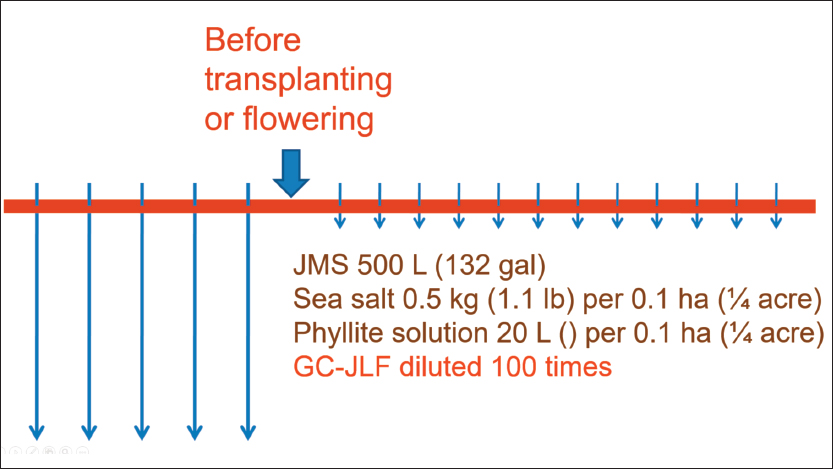
Apply these inputs intensively before transplant/flowering so that soil condition is fully improved and nutrients are sufficient. Continue using these after planting/flowering in smaller quantities.

The soil has been applied with JMS with a sprinkler. Microbial activity became so strong that the whole surface is covered with hyphae

If you apply JMS heavily before transplanting, root settlement will be extremely strong.
Organic matter in my field should be abundant like the leaf mold in the mountains
If the soil is barren, just putting in microorganisms will not necessarily secure the nutrients needed for plant growth. Certain elements need to be present. Inorganic nutrients such as nitrogen (N), potassium (K), calcium (Ca), phosphorus (P), magnesium (Mg), boron (B) and sulfur (S) are well known. But organic nutrients made of carbon (C), hydrogen (H) and oxygen (O) are also important. Organic nutrient is made from photosynthesis when light, air and water come together. If organic nutrients do not back up the soil, minerals will be dysfunctional. 96% of plant growth comes from organic nutrients and 4% from inorganic nutrients. In an ordinary plant, C, H and O take up about 96% of its dried mass. Major elements of the inorganic nutrients are N, K, Ca, P, Mg, B and S which take up 3.5%; trace elements are Fe, Mn, Mo, Cu, Zn and Co which comprise 0.5%.
Organic matter is broken down by small animals and microorganisms; it is disintegrated and turned to humus. Humus breaks down over time and releases nutrients into the soil thus making it fertile. Coupled with microbial activity, humus turns soil into an aggregate structure with good air permeability and water/fertilizer retaining properties. If humus content increases in the soil due to a large input of organic materials then the soil holds on tight to the various nutrients (K, Ca, Mg, Fe, Zn) so that even frequent rain cannot wash them away and the soil is resistant to erosion. Liquid fertilizers do not have the advantage of humus because they have already turned into pure nutrients. Humus is spelt similar to human. It seems that the nutrients that form a human come from this humus. When we die we all go back to humus. Farmers have great interest in increasing the sugar content (Brix) of their fruits. Organic material content in the soil has a deterministic effect on Brix. In an organic matter-rich environment, active microbial activity produces a lot of sugar that is accumulated in the soil; this helps produce top quality fruits.
JADAM sees microorganisms as “guests.” Guests can leave whenever they like. If they don’t like the soil, then they will leave. Treat your guests with good food, i.e., organic matter. Provide ample organic matter into your soil, then the microorganisms will become more active, happy and willing to extend their stay. The quality of food that I eat decides my health; likewise, the quality of organic matter put into the soil decides the health of the microorganisms and the crops. Enrich your soil with organic materials; however, make sure they are clean, pure and uncontaminated. Organic matter should have little or no antibiotics, chemical fertilizers, chemical pesticides because only then will it boost microorganism activity, which will, in turn, improve crop health and produce better quality fruits. If you are keen to get an overwhelmingly positive response from customers, make doubly sure that you use “pure” organic matter. You need a lot of unadulterated organic matter but the problem is that you also want to lower the cost. How is that done? Certified organic fertilizers cost about 20 dollars per sack – that’s quite expensive! This is a problem. Now, as we have done repeatedly, let us ask nature what to do. Where did the leaf mold get its abundant supply of organic matter?
Nature’s soil supplies 100% of its organic materials by itself. All these wild grass and leaves die and accumulate on soil in autumn; as they decompose, the soil turns rich. JADAM follows this pattern. JADAM suggests you sow seeds (those that do not die in winter) in autumn, let them grow and cut them down in spring. The fallen grass will become excellent base fertilizer. How is it that nowadays the prevalent method of organic farming does not do as nature does but instead, buys inputs from the market and provides it to the soil? These methods are touted as some key knowhow of organic farming. Farmers have to buy rice bran, perilla press cake, oil cake, sawdust, livestock manure and other ingredients from the market, add some more material, adjust the moisture level, add microbes and turn them often. Let us be honest and direct. Such method is making organic farming more and more difficult. Some say the compost has to reach 75°C (167°F) in order to kill off the harmful microbes. They also say that beneficial microbes survive the temperature. Such claim is not backed by science. All organic matter has, for billions of years, decomposed at ambient temperature. Is the nature, as a result, full of only harmful bacteria? Temperature claim is just another trap set up to scam farmers.
In our traditional farming system, there was no composting in the form practiced widely in the organic circles today. Forget the complicated and difficult compost-making and do as nature does. Nature makes it a rule to apply fertilizer: in autumn, on the surface and in raw form. If you insist on adding rice bran, perilla cake and/or other organic matter, mix them together and scatter on the field in autumn. Apply JMS so that microbes can start feeding on them. Using tiller at this stage speeds up the process. After autumn, winter and spring pass, compost will be fully prepared. Fertilize your farm in autumn; not in spring. Things will become so much easier. Another merit of autumn application is that it can prevent larvae damage in spring because there is no food for them in the organic matter that has decomposed completely through fall, winter and spring.
Someone might ask “instead of going through all the trouble of growing grass and turning it into organic fertilizer, would it not be easier to simply use rice bran, perilla pulp and press cakes which are good organic matter in themselves?” Somehow, everybody seems to believe that organic fertilizer equals oil press cakes. There are an infinite number of different organic materials; there are quality differences between them. What is the best organic material? Contrary to common practice and belief, rice bran, perilla pulp and press cakes are not the best of ingredients because they are the leftovers (peel) after the grain, nut and fruit have been extracted of their nutritional essences. They are just the skin of a fruit and are deficient of the comprehensive nutrients that the fruit has. That makes them far from the ideal substance to give to your soil/crops. Fertilizer made from plant skin does not possess the comprehensive nutrients required by plants – it simply increases soil nutrient imbalance. Contaminants are an important cause for soil degradation, however, breaking of the balance in soil nutrients is also a serious hazard. Putting in nutritionally unbalanced food (skin fertilizer) certainly disrupts nutrient balance. That is why it is very beneficial to use the “whole” plant as fertilizer like in JADAM’s cover crop method. If you put in rice bran in the soil, the nutritional balance in the soil changes to a condition more favorable for growing rice. Would you grow tomatoes in that soil? Same for perilla pulp. If you love this input and overuse it, you will ruin your soil. Anything good that is excessive becomes bad. Good and bad are one. Farming is a precision-operation of finding and approaching the optimized nutritional balance for your crop. When you use skin fertilizers, use it in less than 1/10 of the total amount.
Let us get rid of compost method!
Prevalent method of compost-making is too complicated. You have to mix the ingredients, calculate green to brown ratio, build up a pile, adjust the temperature/aeration/moisture, turn them, finish composting by spring and scatter them on soil. JADAM method is very, very simple. In autumn, mix all ingredients together and scatter them on the fields, apply JADAM microorganism solution (JMS) and use tiller to break them down.

Compost pile has been made by mixing rice bran, perilla pulp and other organic matter; putting in microbes; adjusting moisture; and covering with rice straw. It is a tiring work.
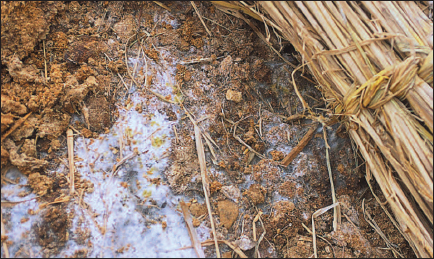
Temperature and moisture differences occur throughout the pile; some parts harden or form clods. You have to turn often to prevent this.
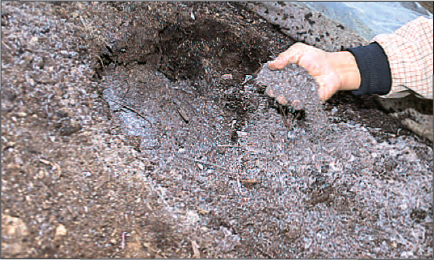
Farmers must complete fermentation so that compost can be applied in spring. They have to work hard all winter long.
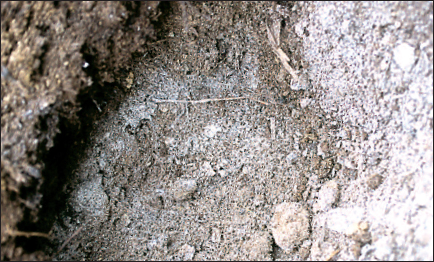
When white color appears and no more heat is generated, the compost is ready. Making this is not easy.
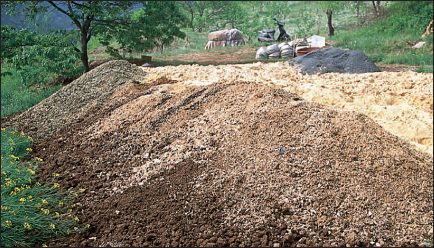
Turning this pile manually will break your back; and what do they tell you? The more you turn, the better.
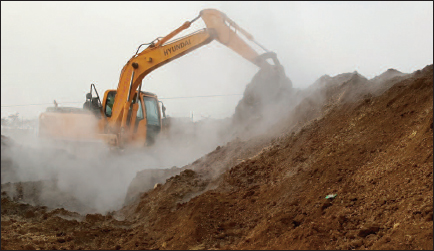
Excavators are mobilized to do the turning. Organic farming becomes difficult; cost rises.
Base fertilizer is very important in farming; and JADAM suggests you do as nature does. Nature always grows vegetation which turn into organic fertilizer. It is always 100% self-sufficient. The amount of organic matter you can acquire through cover crop cultivation is enormous. In addition to providing organic matter, cover crops also soften up the compacted soil layer, reduce salinity and boost microbial activity which in turn suppresses diseases and nematodes. Leguminous crops like hairy vetch and milk vetch even fix nitrogen from the air into the soil. You might be tempted to buy sacks of livestock manure for ease’s sake, however, cover crop method is very important in JADAM organic farming. The Korean Rural Development Administration (RDA) has already done extensive research on cover crop. Below is information based on RDA’s research:
Hairy vetch is a leguminous crop which fixes nitrogen in air and provides 20 kg (44 lb) of nitrogen per 0.1 ha (¼ ac) with a total biomass of about 17 tons (37,500 lb). One of its wonderful qualities is that it inhibits weeds. Its sowing season is between early September and early October (in southern Korea). It needs to be sown by early October at the latest. Use 3-5 kg (7-11 lb) of seeds per 0.1 ha (¼ ac). Sow more if the climate is bad or if you sow them too late. In orchards, cut them down after they have formed seeds; then, you do not need to sow seeds again every year. They wither and die in summer. If a crop is planted before their withering, put them back into the soil by using a rotary two weeks prior to planting so that they have time to decompose. If crops are planted at a later period, then hairy vetch can be left to die and mulch the field. They grow well in sandy soil or loam with good drainage and are weak to excessive moisture. With a low carbon-nitrogen (C/N) ratio of around 10, it breaks down fast.
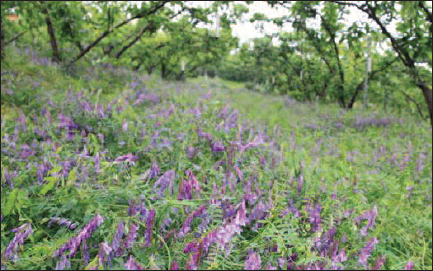
Hairy vetch growing on an orchard. Being leguminous, they provide all the nitrogen needed by the fruit trees.
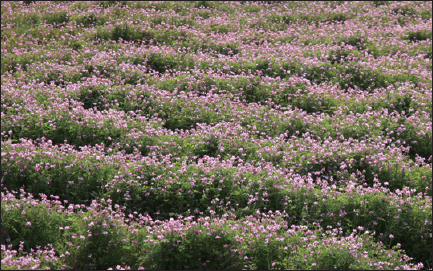
Milk vetches are planted in rice paddies. Being leguminous, they can provide the entire nitrogen needed for growing rice.
Milk vetch is a leguminous crop like the hairy vetch. It fixes nitrogen from the air and provides 15 kg (33 lb) of nitrogen per 0.1 ha (¼ ac). Its total biomass is about 17 tons (37,500 lb). In Asia it has been used as a green manure plant for thousands of years. It had been composted after having been mixed with soil. Sowing season is before September 20-25 in the southern area and before mid-September in the central area. For good germination, milk vetch should be sown when there is sufficient moisture in the soil. Milk vetch is vulnerable to cold and it can freeze to death if the temperature stays at below -5°C (23°F) for a long time. You can turn the vetch into the soil after May 25 after they seed so that you will not need to re-sow.
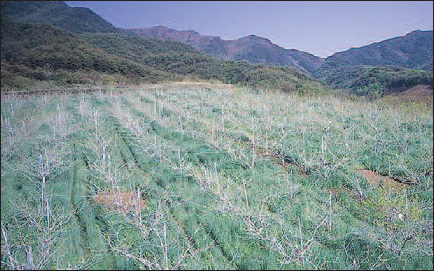
Rye is planted in this orchard. “Experts” say that because rye has low nitrogen content, when it decomposes it will cause nitrogen suck-in by microorganisms and thereby damage the growth of fruit trees. However, in the fields, such concern is dismissed. The orchard produces more every year. The owner of this farm has done tree-rye symbiosis cultivation for over 20 years. (Mr. Jaegwan Yu, Hadong)

Weight of rye on 1 square meter (11 sq. ft.) was 18 kilograms (40 lb).
Rye is a gramineous crop. It is very tolerant to cold and can survive temperatures below -25°C (-13°F) in the central and northern areas. It provides 15 kg (33 lb) of nitrogen per 0.1 ha (¼ ac) with a total biomass of 20 tons (44,092 lb). It has strong nutrient absorption so is an excellent source of green manure. It is also helpful in eliminating salt from the soil. It has a vigorous root growth which greatly improves the physical characteristics of the soil and helps with soil compaction. Sowing season is between late September and early October for high lands and between mid-October to late October for other regions and Jeju Island. The crop will sprout in just four days even in soil temperatures of 4~5°C (39.2-41°F). Sow about 15 kg (33 lb) per 0.1 ha (¼ acre). Mixing hairy vetch and rye in a three to one ratio is an excellent method as that supplements the low nitrogen of the rye. Return them into soil immediately before the heading stage.
Sudan grass is a typical annual summer crop. It is good as green manure and removes salt from soil in protected cultivations. It is tolerant of high temperatures and draught, and easy to grow. Its early growth is slow but it grows very fast after rooting. Even in the short-term, it produces a lot of organic matter that can be returned to the soil. As the fast growth rate allows four to five times of cutting every year, it can be used as a feed crop. It helps reduce nematode damage and is good for curing problems from repeated monoculture. A good time to sow is in the summer when the temperature is high because it sprouts when the average temperature is over 15°C (59°F). The seeding rate is 4-5 kg (9-11 lb) per 0.1 ha (1/4 acre) in case of broadcast-seeding and 2-3 kg (4.4-6.6 lb) for line-seeding with thin soil covering. To use as green manure, cut and return to the soil before heading. To reduce salt from soil under protected cultivation, grow them for over 60 days to let them absorb the salt, then remove them. High groundwater level or alkalinity causes poor growth.
Rapes are one of the most common green manure crops with no part to be wasted. After oil is pressed out of it, the pulp is mixed with urine and excrements to produce organic fertilizer. Rape honey is a premium honey that can be harvested in April and May. As it is so with barley, rapes can be double-cropped with rice. Rapes can be harvested in early June and transplanting of rice seedlings can be done around June 20. Sowing season is early October and seeds can be broadcasted at a rate of 0.5 kg (1.1 lb) per 0.1 ha (¼ ac). In rice paddies, drainage is necessary to prevent winter-time moisture damage. Its optimum germination temperature is 20-25°C (68-77°F). The lowest it can tolerate is 0-2°C (32-35.6°F). Rapes are vulnerable to cold; they grow in the southern part of the country and Jeju Island. If they are sown after Oct 20, they will be prone to cold damage during winter so sowing them at the correct time is vital. Today most of our cooking oil is imported. But until the mid-60s, we produced 72.4% of our cooking oil. Rape seeds had 38-45% oil content and thus made for a valuable resource. A good time for combine harvesting is when seeds turn completely black. When you harvest with a sickle, it is better to harvest a little earlier – when the seeds begin to turn black. Wheat and barley are effective when they are grown with fruit trees that are not tall, such as grapes. Like rye, using in a mixture with hairy vetch is a good idea, where the ratio of hairy vetch to wheat or barley is three to one.
There is a whole variety of plants that can be grown in winter and summer, in between the main crop’s growth cycle. Provide the base fertilizer with the crop residue and cover crop. After doing this, provide any additional fertilizer as required. If growing cover crop is difficult, use manure that came from grass-eating animals. Manure from herbivorous animals contains optimum nutritional balance for crops. Nutritional balance is the key to high yield and quality.
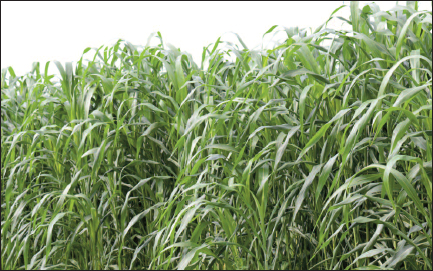
Sudan grass grows very fast and can be used in greenhouses. Corns can replace Sudan grass.

Rapes are planted in rice paddies. They grow as tall as a person. One great feature is that you can collect seeds for next use. It also helps suppress weeds in the rice paddy.

Rye seeds have been broadcasted before harvesting persimmons. Seeds have sprouted. Best nutrient for persimmon is its own leaves; leaves fall in between rye plants so they are not blown away. No nutrient is lost; all is recycled back into the soil. This is a perfect fertilizer program.
Minerals in my field should be diverse like the leaf mold in the mountains
Surface-layer soil where most crop roots are located is called the “plow layer”; it is usually about one meter (3.3 ft) deep. When we pick fruits, where did their nutrients (96% organic, 4% inorganic) come from? Most of the organic nutrients would have been supplied by photosynthesis while a small portion of organic and inorganic nutrients came from the plow layer. As fruits are harvested, the nutrients in the plow layer are taken out. The leaching of organic nutrients can be replenished through photosynthesis; however, the leaching of minerals is almost irreversible. JADAM has coined the term “the natural leaching of minerals” to refer to this kind of inevitable loss of minerals through the practice of agriculture. In the 1940s in the US, there was a saying that “an apple a day keeps the doctor away” because an apple had all the minerals that a person needed in a day. However today you would need thirty-two apples to keep the doctor away because present-day apples are so much poorer in minerals!
Many data point to the fact that all the vegetables and fruits we eat today are highly deficient in minerals compared to the past. Why is that so? JADAM sees it as a result of the continued process of natural leaching of minerals. After agriculture shifted from self-sufficiency to commercialism, leaching of minerals has been accelerated. Some say that there are eighteen elements that are required for plant growth. Do not believe this because this is the conclusion arrived only by “today’s” agricultural science. If science advances then it will find more essential plant nutrients. For humans – the object of science’s greatest interest – the number of essential minerals is over seventy. Note that ten years ago the number was sixty. Science is always advancing. Its conclusions are subject to changes. As science makes continued progress, the world of agriculture will also widen. It is not a true science that suffices in the findings made to date and makes no efforts to progress. Science shelters only under canvas for it has to always move on. Unfortunately most scientific studies nowadays have more of a commercial focus rather than serving the public interest; “good” science is hard to find. That is why I cannot stress enough the importance of being able to master the skills, knowledge and technology you need for your farming, always putting to maximum use your own common sense and intuition.

Cucumber leaves are not a source of disease. Cucumber leaves contain nutrients for cucumbers. They should be returned back to the soil. Look how thin thread-like roots are approaching the leaf to absorb the nutrients
Apart from the “natural leaching of minerals” there is also the “forced leaching of minerals.” Whereas natural leaching is the deprivation of the nutrients from the soil mainly because the fruits take them, forced leaching refers to the process where nutrients are deprived due to the foolish human practice of removing crop residues. As crop roots stretch into the soil, roots select what the plant needs and absorb them. The difference in the nutrient content of each and every fruit is reflected by the different nutrients imbibed by the roots. Stems and leaves are made from nutrients absorbed by the roots. These nutrients are particularly selected from the “pool of nutrients” present in the soil. This pool is under a significant threat.
There is one thing repeatedly stressed to farmers in agricultural workshops: that they must completely eliminate crop residues to have fewer diseases and pests the next season. It’s called field sanitation. So well-meaning, diligent farmers go about getting rid of the smallest scrap of residue. They expect that they would at least save some money from reduced use of pesticide next year. Let’s stop and think: if what the experts said were true, then the amount of pesticide used every year should have kept decreasing, so that by now once or twice a season should suffice. But that is exactly the opposite of how things are going. Each year, farmers are more deeply entangled in the trap of pesticides. What more evidence to prove them wrong? By promoting the elimination of crop residues, current system of agriculture is eventually encouraging farmers to remove nutrients from the soil. Who is the winner? Needless to say, fertilizer and pesticide companies. Current agricultural practice leaves the soil deprived of nutrients and that calls for more market-bought fertilizers and pesticides. It is a vicious cycle. Diseases to plants and soil should be perceived as a “cold”. Everybody is exposed to the cold virus but healthy people do not catch it. If plants and soil are healthy, they will not easily fall prey to the ever-present disease-bearing elements. Some argue that health runs in the family because of the DNA, but that is not true. Even DNA can change according to the environment.
Health is neither accidental nor destined; it is the result of effort. How you eat, drink, exercise, move your body, and operate your mind all matter. It is not because the crop was unlucky that it fell sick. Look at what kind of environment your crop is in. Natural and forced leaching of minerals is progressing in the soil. All sorts of chemical contaminants new to the environment are entering the soil. I daresay that farming that tells you to get rid of your crop residue is not a farming at all. That kind of farming is a direct harm to agriculture and nature. If you want to grow rice well, use rice straw as fertilizer instead of selling it and buying some other fertilizer from the market. People follow and practice a costly form of farming and yet complain that their farming is costly. Farming that treats crop residue as waste is waste. It is an exploitation of nature.
There are some advocates of zero-input agriculture. They argue that they can farm without adding anything – no nutrients, no water, nothing. I see farmers attracted to this kind of theory, but how can this kind of nonsense gain any popularity? Unless you are going to farm just a few years, this theory absolutely does not stand in the face of reality. Zero-input is possible only in nature. That is because all the leaves and the fruits fall to the ground. They are broken down and nutrients are recycled. Come to look at it, nature’s process is not even zero-input; it is a complete recycling, everything re-input. Nutrients do not flow away; instead they stay in a closed loop.
Farming has a completely different process. Here humans take away all the fruits; sometimes fruits are harvested more than once a year. As a result, soil is exploited and the cycle of nutrients is clearly broken. How then can a farming stand with zero-input, without compensating for what humans have taken away? Human intervention for human-caused damage is all but necessary because farming is not same as nature: in nature all beings share; in farming, humans take all. Do not seek miracles in farming; comply only with science. What is taken out needs to be put back in. Organic nutrients come from the sun, air and water which are infinite resources. However that is not the same for inorganic nutrients. Minerals are finite resources and, like oil pumped out of the earth, what is taken out is taken out. They are not reproduced endlessly through the operation of the sun, earth and water.
Zero-input farming can be successful for a short time if the soil is excessive in nutrients because there is a lot to exploit. But this cannot go on for tens or hundreds of years. If zero-input is such a successful method then our ancestors have done needless things for the past four thousand years – using excrement, urine, livestock manure, green manure and residues to fertilize the soil. Some zero-input advocates from Japan use vinegar for pest control. That is literally not zero-input. Applying vinegar is same as providing foliar fertilizer. JADAM strictly adheres to a scientific thinking. As Adam Smith put it: “Science is the great antidote to the poison of enthusiasm and superstition.”
How much and what minerals have been taken out of my soil through the process of natural leaching? This is very difficult for even scientists to measure. But taking a super macro-view can give us an insight. Let us look at this problem of leaching from a “global” view. Then it is easier to find out where the minerals taken out of my soil have eventually gone: the sea. For hundreds of years, my soil has experienced leaching of nutrients; to cure it, we will bring back the nutrients from the sea. The mineral content of sea water is strikingly similar to that of the amniotic fluid of a mother. The mineral balance of plasma which is made from eliminating red and white blood cells from blood is very similar to that of plant fluid and sea water. That is why biologists claim that both fauna and flora came from the sea. Sea water is quite a mysterious thing. The human fetus goes through the entire process of evolution again. In the beginning it has a tail then it disappears. After ten months, it grows to the shape of a homo sapiens.
To date, 83 elements have been found to be present in sea water. Most of the elements that make up the earth are in the sea water; not only Mg, Ca, K and P which are essential for crop growth but also other various minerals such as I, Mn, Mo, Co, Se and Ge. About 100 million marine microorganisms live in 1 mL of sea water. This makes it an excellent ingredient to mix with the JADAM indigenous microorganism solution (JMS) which is bred from microorganisms collected from leaf mold. If you mix the two types of water together, then you essentially have all the diversity Earth has to offer: from the land and from the sea. That could be why if you do a foliar application of JMS and sea water, you have no more powdery mildew. Let us make good use of sea water to fight the leaching of nutrients from our soil. Note that since sea water is around 3% salt and the body fluid of plants is around 1%, you must mix the sea water with thirty to one hundred times more plain water. This is to prevent salt damage to plants and accumulation of Na and Cl in soil. JADAM recommends using 20 liters (5.28 gal) (or 600 grams (1.3 lb) of sea salt) for 0.1 ha (¼ ac).
83 identified elements in seawater
| Element (form) | Mean concentration (ng/sea level 1 kg) | |
| Cl | Chlorine(Cl-) | 19,360,000,000 |
| Na | Sodium (Na+) | 10,780,000,000 |
| S | Sulfur (SO4 2-) | 2,710,000,000 |
| Mg | Magnesium (Mg2+) | 1,280,000,000 |
| Ca | Calcium (Ca2+) | 417,000,000 |
| K | Potassium (K+) | 399,000,000 |
| Br | Bromine (Br -) | 67,000,000 |
| C | Carbon (HCO3-) | 26,000,000 |
| N | Nitrogen (H2NO3-)  |
8,270,000 |
| Sr | Strontium (Sr2+) | 7,800,000 |
| B | Boron | 4,500,000 |
| Si | Silicon (H2SiO1) | 3,100,000 |
| O | Oxygen | 2,800,000 |
| F | Fluorine (F-) | 1,300,000 |
| Ar | Argon (Ar) | 480,000 |
| Li | Lithium (Li+) | 170,000 |
| Rb | Rubidium (Rb+) | 120,000 |
| P | Phosphorus (H2PO4-) | 62,000 |
| I | Iodine (IO3-) | 58,000 |
| Ba | Barium (Ba2+) | 16,000 |
| Mo | Molybdenum (MoO42-) | 11,000 |
| U | Uranium (UO2(CO3)34-) | 3,200 |
| V | Vanadium (H2VO42-) | 2,000 |
| As | Arsenic (HAsO42-) | 1,700 |
| Ni | Nickel (Ni2+) | 470 |
| Zn | Zinc (Zn2+) | 390 |
| Cs | Cesium (Cs+) | 310 |
| Cr | Chrome (CrO42-) | 260 |
| Sb | Antimony (Sb(OH)6-) | 240 |
| Kr | Krypton (Kr) | 230 |
| Se | Selenium (SeO42-) | 160 |
| Ne | Neon (Ne) | 140 |
| Cu | Copper (Cu(OH)20)  |
130 |
| Cd | Cadmium (CdCl20)  |
70 |
| Xe | Xenon (Xe) |
66 |
| Fe | Iron (Fe(OH)30) | 34 |
| Al | Aluminum (Al(OH)30) | 27 |
| Tl | Thallium | 25 |
| Re | Rhenium (ReO42-) | 19 |
| Zr | Zirconium (Zr(OH)40) | 18 |
| Mn | Manganese (Mn2+) | 16 |
| Y | Yttrium (YCO3+) | 13 |
| W | Tungsten (WO42-) | 10 |
| He | Helium (He) | 6.8 |
| Ti | Titan (Ti(OH)4 0)  |
6.2 |
| La | Lanthanum (La3+) | 2.6 |
| Ge | Germanium (H4GeO4) | 5.1 |
| Nb | Niobium (Nb(OH)6-) | 5> |
| Nd | Neodymium (NdCO3+) | 3.6 |
| Hf | Hafnium (Hf(OH)40) | 3.4 |
| Ag | Silver (AgCl2+) | 3.2 |
| Pb | Lead (PbCO20) | 2.7 |
| Ta | Tantalum | 2.5 |
| Er | Erbium (ErCO3+) | 1.3 |
| Dy | Dysprosium (DyCO3+) | 1.3 |
| Gd | Gadolinium (GdCO3+) | 1.3 |
| Ce | Cerium (CeCO3+) | 1.3 |
| Co | Cobalt (Co2+) | 1.2 |
| Yb | Ytterbium (YbCO3+) | 1.2 |
| Ga | Gallium (Cu(OH)20)  |
1.0 |
| Pr | Praseodymium (PrCO3+) | 0.8 |
| Te | Tellurium (TeO3+) | 0.7 |
| Sc | Scandium (Sc(OH)30)  |
0.7 |
| Sm | Samarium (SmCO3+) | 0.6 |
| Ho | Holmium (HOCO3+) | 0.6 |
| Sn | Tin (SnO(OH)3-) | 0.5 |
| Hq | Mercury (HgCl42-) | 0.4 |
| Lu | Ruthenium (LuCO3+) | 0.4 |
| Tm | Thulium (TmCO3+) | 0.3 |
| Tb | Terbium (TbCO3+) | 0.24 |
| Pt | Platinum (Pt) | 0.20 |
| Be | Beryllium (BeOH-)  |
0.20 |
| Eu | Europium (EuCO2+) | 0.18 |
| Rh | Rhodium (Rh) | 0.08 |
| Pd | Palladium (Pd) | 0.06 |
| Th | Thorium (Th) | 0.05 |
| Bi | Bismuth (BiO+) | 0.03 |
| Au | Gold (AuCl2-) | 0.03 |
| In | Indium (In(OH)30) | 0.02 |
| Ru | Ruthenium (Ru) | 0.005 |
| Os | Osmium (Os) | 0.002 |
| Ir | Iridium (Ir) | 0.00013 |
| Ra | Radium (Ra) | 0.00013 |
* Oxygen and hydrogen, components of water, are excluded from the table.
* 1 g = 1,000 mg, 1 mg = 1,000 ug, 1 ug = 1,000 ng
Source: Ocean March 2000, Resources in the 21st Century/ Potential Biological Productivity and Resources—Writer: Professor of Department of Oceanography at Graduate School of East Coast University
Mix sea water with JMS and continue applying it 3-4 times a month. Using sea water not only supplements minerals leached out of the soil but also improves sweetness, coloring, storing period and product value. If you look at the sea water composition, it has plenty of S, Mg, Ca, K, B, P, I which are all essential for crop growth. It even has Se and Ge which are known to be extremely beneficial. That is why JADAM strongly suggests the use of sea water as mineral supplement for plants. Even the Korean National Institute of Agricultural Sciences has confirmed the benefits of sea water and/ or sea salt. It is the sales agents of agricultural inputs that adamantly oppose the use of sea water/salt. Benefits of sea water have been proven through history. Fields, rice paddies and orchards by the sea were showered with sea water elements for hundreds and thousands of years. They produce better quality food than inland farms. What clearer evidence is needed?
However, take care not to apply sea water mixed with less than thirty times water because then the salinity will be too strong which can damage some crops. Do not sprinkle salt directly onto soil or spray undiluted sea water! Remember that good and bad are one. If a good were excessive, it will turn bad. If you cannot obtain sea water, then sea salt can be used. 20 liters (5.28 gal) of sea water is equal to around 500 grams (1.1 lb) of salt. Calculate your dilution ratio based on this conversion. The salinity of sea water differs according to regions; normally it is between 3.1-3.8%. It is generally accepted as sea water if the salt concentration is above 1.7%.
There is another ingredient that JADAM uses to supply mineral to the soil. Use fine-powdered phyllite as mineral supplement. This rock contains almost all inorganic nutrients required by plants. Use it together with sea water and you will be surprised. Phyllites are sold in powder form and are inexpensive. Add 60 kg (132 lb) of phyllite powder to 500 L (132 gal) of water. Stir and let it settle. Scoop out the upper water for use. Refill the water when you need. Use like so for one year. JADAM calls this water “phyllite solution.” In soil with serious mineral leaches, directly sprinkle phyllite powder to the soil (approx. 1 kg (2.2 lb) per 3.3 square meters (36 sq. ft.).

JADAM encourages the use of phyllites to replenish the soil of minerals

Put in 60 kg (132 lb) of phyllite and add water. Stir and let sit for a few hours. Use the upper portion of the water. Refill with water and repeat use. Use throughout the year
Fauna and flora that once lived all die and their bodies are piled up. When pressure is applied they become sedimentary rock. Higher pressure and temperature turn them into metamorphic rocks then granites. Rocks made from the accumulation of organic matter contain materials closest to the mineral requirements of plants. If phyllite is not available, use other rock powders.
Humus soil is also beneficial. It helps to distinguish leaf mold soil, humus soil and humic acid. Leaf mold soil is the soil we easily see under a pile of leaves in the mountains. When leaf mold is exposed to microbial activity for tens of thousands of years, it turns into humus soil. Because microorganism activity is almost finished, humus soil will not generate any heat in soil. If humus soil is further disintegrated, it turns into various humic acids. These are much more expensive than humus soil. The price of humus soil is not much different from livestock manure so JADAM recommends the use of humus soil. Humus soil is the optimum pure organic fertilizer with abundant minerals and organic nutrients. In Korea, it is mined from ancient bogs. To use for fruits and vegetables, it is more effective if some nitrogen is added.
To improve your soil quality and fight mineral leaching, use JMS, sea water and phyllite solution every time you water. Your crops will show visible improvements in their growth and root settlement. Needless to say that the taste, aroma and market value of the fruits will soar! Take caution because this is such a powerful method that it can suddenly break down the insolubilized nutrients in the soil and boost plant growth and produce water sprouts. It can also delay fruits from ripening. So JADAM recommends this method to be used starting from before the transplanting or growth period. I cannot stress this enough. It is the most important technology of JADAM: “Apply JADAM indigenous microorganism solution (JMS), sea water, and phyllite solution every time you water.” Use sea water/salt and phyllite solution every time you use JADAM microorganism solution. Soil foundation work is the most important of all farming tasks: use JMS, sea water, phyllite solution and wild grass JADAM liquid fertilizer (JLF) to optimize the soil condition before transplanting or flowering. This is the key to strong root settlement and thus high quality and high yield.
 Other effects of the leaf mold-method of soil management
Other effects of the leaf mold-method of soil management
Increased diversity of microorganisms prevents a particular type of pathogen from gaining dominance. Nowadays, soil-borne diseases and nematode damage are ever on the rise. Even the most toxic chemical pesticides cannot control powdery mildew. All along, our method has relied on disinfection. We thought killing the target pathogen would save us but it is not working that well. What is worse, the pathogens are building resistance towards chemical pesticides. It is time we drastically shift our thinking. Disease is caused when a certain virus, bacteria or pest takes control over the soil. So JADAM’s solution is simple. Maximize the population and diversity of soil microorganisms. As I mentioned, add JMS whenever your crop is watered. This is a complete shift. Mankind has concentrated on killing and eliminating pathogens when there was an easier and effective method of using microbes to check microbes (pathogen). Let us shift from disinfection to diversity. Most of the pathogens are heterotrophic; meaning they cannot produce nutrition for themselves but have to rely on foreign sources of nutrients. This means that the “area” they occupy is directly interpreted into the amount of food they acquire. What do we want to achieve by repeatedly showering crops and soil with JMS? We want the army of diverse microorganisms to occupy the area and crowd out the pathogens. When the micro-ecology recovers its natural diversity, no particular pathogen will be able to multiply in extraordinary numbers and take control.
The same holds true for soil nematodes. When microorganism diversity and activity are recovered in the soil, the nematodes become much less active. There are interesting pictures of a certain fungi using hyphal loop to trap and consume nematodes. Bactericides might have some success in controlling powdery mildew; however, the disease can also be controlled by foliar application of microorganism solution. Indigenous microorganisms will occupy the area that the powdery mildew pathogens would want to take up, effectively preventing the outbreak of powdery mildew. This costs almost nothing, and contrary to chemical agents, application of such material actually promotes plant health. If you are trapped in your belief that only pesticides can save you, then you will forever rely on them. Think outside the box; nature has all the answers. Follow nature and things will be surprisingly simple, easy, scientific and effective (SESE). Ultra-low-cost farming is so easy!

Leave the crop residues on the soil. Add some organic matter and fully wet with JMS. Cover them from the sun and soon the soil will be full of hyphae. Microorganisms, sea water and phyllite solution play an important role in improving the physical and chemical qualities of the soil.
Minerals become abundant with JADAM farming, solving any issues of mineral deficiency. Farming should become easier and simpler with age and experience. But farming nowadays becomes ever more difficult as years go by; the main reason is mineral deficiency. Most farmers have a few mineral products they favor and use those frequently, but the problem seems nowhere close to being solved. Modern science cannot say for sure which mineral is deficient and in what quantity. It cannot even clearly distinguish between insolubilized and solubilized nutrients. That is why all soil evaluation results are extremely inaccurate. JADAM’s way of thinking is that, compared to human diet, you do not try to find out which particular mineral you lack; rather, you try to recover the diversity and balance of minerals by eating a wholesome diet. This is a simple yet outside-the-box approach. Diversify your soil microorganisms. This means that your soil is filled up with different microorganisms with different diets. Different diet means different processes of nutrient digestion and excretion. In other words, diversity of microorganisms means diversity of nutrients available for plants. In sum, the diversity within the soil ecosystem supports the diversity of available nutrients.
In addition, sea water with its 83 different minerals is put into the soil combined with phyllites. Your soil will never be richer in minerals. The minerals in your soil recover both in terms of diversity and quantity. Crops will recover from mineral-deficiency. Conventional farming is like eating junk food and then taking vitamin pills for health. Just eat wholefood from the first place. Thoroughly understand the world of balance and diversity of microorganisms, balance and diversity of nutrients. This is the essence of JADAM. This is what makes farming so easy, so effective and so ultra-low-cost.
Soil nutrient-tolerance increases; complicated skills are not needed anymore. All nutrients have their optimum levels. Deficiency is bad but excess is no better. Frequent acid rain and soil acidification cause problems. For example, ionization of aluminum (Al) leads to root rot. There is no known solution to this problem. However, constant input of JADAM microorganism solution (JMS), seawater and phyllite solution into the soil significantly reduces root rot. This is due to the excess aluminum being absorbed by microorganisms that like aluminum and therefore the aluminum being removed from the soil. Because aluminum is kept in the microorganisms’ bodies, the soil aluminum level is kept at an optimum level. This is increased nutrient-tolerance.
These things are not yet fully understood. JADAM thinks that the microbial balance and diversity is directly linked to soil nutritional balance and diversity, and because nutrient balance is optimized, the soil is less sensitive to excess or deficiency of certain nutrients. There is a tendency where the more experienced a farmer is, the more s/he thinks soil management is difficult. JADAM thinks differently. Choose leaf mold. Don’t choose microbes. Use all. Good and bad are one. Do as nature does. JADAM’s method is easy because here, opening one door automatically opens ten other doors.
Quite often you hear about people discussing the pH of the soil. This is more so among the educated farmers. Invariably, they try to control the soil pH by putting in lime, silicic acid, oyster shell powder, etc. JADAM thinks differently. Just stick to JADAM microorganism solution and cover crops. Apply microorganism solution every time you water. Add crop residues and organic matter to soil. Naturally, the soil pH will return to normal. Inputting minerals might change the acidity in a short time but raises the possibility of disrupting the soil nutrients balance in the long run. Remember that you cannot take out what you put in the soil. Not one single mistake is acceptable in soil fertilization. Take it as seriously as you would take seriously what you put into your mouth. Soil is still little understood; be humble about your limited knowledge and be aware of things that you cannot reverse.
Many blueberry farmers raise the problem of acidity related to the use of microorganism and liquid fertilizers. They think they have to make these inputs acidic because this crop is acid-loving. But this is not necessary. Come to think of it, the largest quantity of water blueberries receive is not liquid fertilizer but rainwater. The pH of rainwater is around 6.0 which is much closer to neutral than what farmers would like to give blueberries (pH 4.5). Blueberries receive rainwater in abundance but have no problem at all.
Seed and seedling treatment using leaf mold
Leaf mold is a reservoir of millions of different kinds of indigenous microorganisms. It also holds millions of different excreta from these microorganisms. It is a super nutrient-rich material that can easily replace commercial root promoters. Try leaf mold in your seed and seedling treatment. This substance will boost the biodiversity in the seed and seedling environment which in turn effectively suppresses the outbreak of diseases. Bring leaf mold from mountains nearby. Prepare a large bucket, put in about 3 kg of leaf mold and add water up to a level where the root part of the seedling will be submerged. Allow the seedlings to rest in that solution for 1-2 minutes so that they are fully soaked; then transplant. If you have a lot of seedlings to treat, dig out a wide area of soil, cover with plastic, fill in water and put in leaf mold. For seeds, put them in a porous bag and leave submerged for around 30 minutes before planting.
JADAM’s view is that canker and athlete’s foot are essentially the same. Chemical pesticide cannot control canker; medicine rarely fixes athlete’s foot. However, when you tackle them with microbial diversity, the diseasecausing organisms are neutralized. This is why this simple seed and seedling treatment promotes root settlement and disease prevention at the same time.
